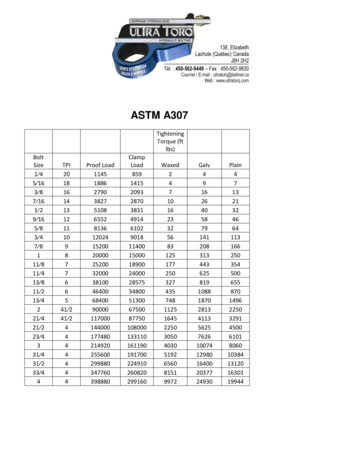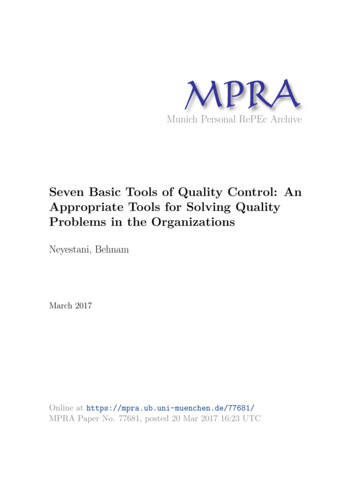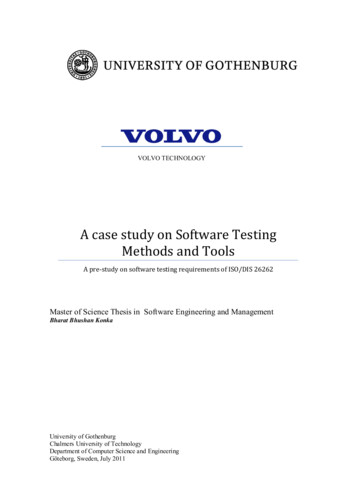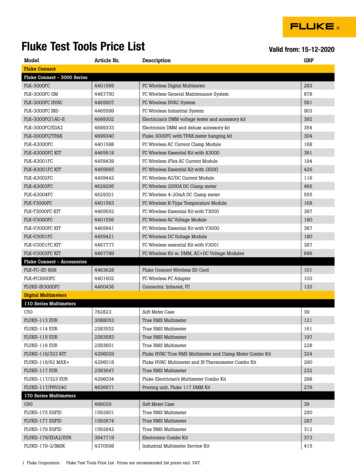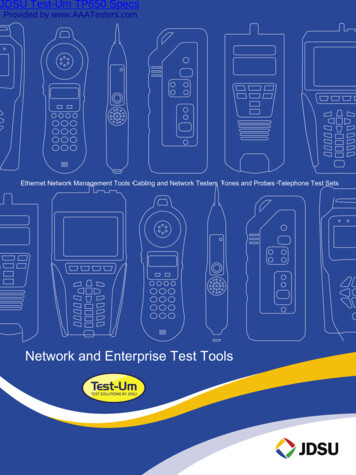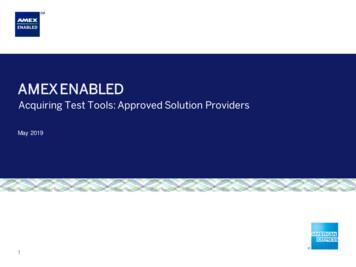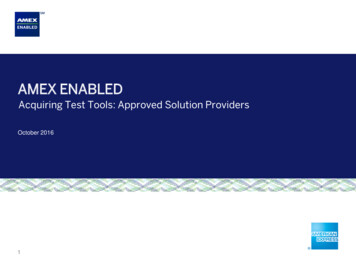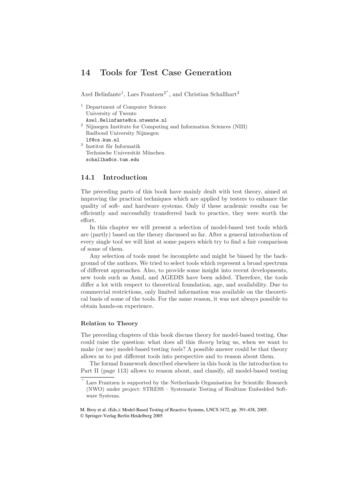
Transcription
14Tools for Test Case Generation Axel Belinfante1 , Lars Frantzen2 , and Christian Schallhart3123Department of Computer ScienceUniversity of TwenteAxel.Belinfante@cs.utwente.nlNijmegen Institute for Computing and Information Sciences (NIII)Radboud University Nijmegenlf@cs.kun.nlInstitut für InformatikTechnische Universität Münchenschallha@cs.tum.edu14.1IntroductionThe preceding parts of this book have mainly dealt with test theory, aimed atimproving the practical techniques which are applied by testers to enhance thequality of soft- and hardware systems. Only if these academic results can beefficiently and successfully transferred back to practice, they were worth theeffort.In this chapter we will present a selection of model-based test tools whichare (partly) based on the theory discussed so far. After a general introduction ofevery single tool we will hint at some papers which try to find a fair comparisonof some of them.Any selection of tools must be incomplete and might be biased by the background of the authors. We tried to select tools which represent a broad spectrumof different approaches. Also, to provide some insight into recent developments,new tools such as AsmL and AGEDIS have been added. Therefore, the toolsdiffer a lot with respect to theoretical foundation, age, and availability. Due tocommercial restrictions, only limited information was available on the theoretical basis of some of the tools. For the same reason, it was not always possible toobtain hands-on experience.Relation to TheoryThe preceding chapters of this book discuss theory for model-based testing. Onecould raise the question: what does all this theory bring us, when we want tomake (or use) model-based testing tools? A possible answer could be that theoryallows us to put different tools into perspective and to reason about them.The formal framework described elsewhere in this book in the introduction toPart II (page 113) allows to reason about, and classify, all model-based testing Lars Frantzen is supported by the Netherlands Organisation for Scientific Research(NWO) under project: STRESS – Systematic Testing of Realtime Embedded Software Systems.M. Broy et al. (Eds.): Model-Based Testing of Reactive Systems, LNCS 3472, pp. 391-438, 2005. Springer-Verlag Berlin Heidelberg 2005
392Axel Belinfante, Lars Frantzen, and Christian Schallhartapproaches, even those that are not aware of it. An example is given in Section 14.3.1, where the error-detecting power of a number of model-based testingtools is compared by looking at the theory on which the tools are based.The formal framework also allows to reason about correctness, not only ofthe implementation that is to be tested, but also of the testing tool itself, as wewill see below.The key concept of the formal framework is the implementation relation (orconformance relation). It is the most abstract concept of the framework, sinceit has no “physical” counterpart in model-based testing, unlike concepts likespecifications, test suites or verdicts. The implementation relation relates theresult of test execution (so, whether execution of tests generated from the modelfailed or passed) to conformance (or non-conformance) between the model andthe SUT. The idea is the following. Suppose a user has a model, and also an ideaof which (kind of) implementations the user will accept as valid implementationsof the model – an implementation that according to the user is a valid one issaid to conform to the model. The user will then derive (generate) tests on thebasis of (from) the model. The idea is that if the SUT conforms to the model,then the execution of all tests that are generated on the basis of the model mustbe successful. Here conforms to is formalized by the implementation relation.Therefore, any tool defines an implementation relation, explicitly or implicitly.If the implementation relation is defined implicitly, it may still be possible tomake it explicit by analyzing the test derivation algorithm implemented in thetool, or maybe even by experimenting.The implementation relation is embodied in the test derivation algorithm.This is reflected in the theoretical framework by the concept of soundness, whichsays that the generated test cases should never cause a fail verdict when executedwith respect to a correct (conforming) implementation. A related concept iscompleteness (or exhaustiveness) which says that for each possible SUT thatdoes not conform to the model, it is possible to generate a test case that causesa fail verdict when executed with respect to that SUT.If one knows that a tool implements a test derivation algorithm that is sound,analyzing unexpected test execution results may be easier, because one knowsthat the tool will never generate test cases that cause a fail verdict that was notdeserved. The unexpected result may be caused by an error in the SUT (this iswhat one hopes for), but it may also be caused by an error in the model, or byan error in the glue code connecting the test tool to the SUT. However, (as longas the test derivation algorithm was implemented correctly) it can not be causedby the test derivation tool. Without this knowledge, the error can be anywhere.Also completeness of the test derivation algorithm has important practicalimplications. In practice one is only able to execute a limited number of tests,so one may be unlucky and no distinguishing test case is generated. However, ifone does know that the test derivation algorithm is complete, one at least knowsthat it does not have any “blind spots” that a priori make it impossible for it tofind particular errors. So, if one has a SUT that is known to be incorrect (nonconforming), and one tries hard and long enough, one should eventually generatea test case that causes a fail verdict for the SUT. In contrast, if one applies a
14Tools for Test Case Generation393test derivation algorithm for which one knows that it is not complete, one alsoknows that there are erroneous implementations that one can never distinguishfrom correct ones, and it makes no difference whether or not one tries long orhard, because the inherent blind spots in the test derivation algorithm simplymake it impossible to generate a test case that causes a fail verdict.14.2Tool OverviewToolLutessLuretteGATeLAutoFocusConformance 24427429431LanguagesCAR MEFSMRFSMSDL, EstelleRFSMAsmLRFSM?LTS (Basic LOTOS)ALTSLTS-API (LOTOS, SDL, UML) ALTSLTS (LOTOS, Promela, FSP)ALTSNTIFALTSUML/AMLCARLTSSDLC LTS/EFSM?SDLCTable 14.1. Test ToolsTable 14.1 lists the tools that will be presented in more detail below. Fromleft to right, the columns contain the name of a tool, the section in which itis discussed, its starting page number, the input languages or APIs, its originor availability (whether it was developed by an Academic institute, by a nonuniversity Research institute, or whether it is Commercially available), and thetest derivation method used in the tool (CLP stands for testing based on Constrained Logic Programming, FSM stands for testing of Finite State Machinesand LTS stands for testing of Labeled Transition Systems). For some tools weleft the Method entry open because the method implemented in the tool differedtoo much from those discussed in the theoretical chapters.From top to bottom the table shows the tools in the order in which wewill present them. Unfortunately, there is no simple single criterion to orderthem. Therefore, we ordered them by input language and test derivation method.We start with tools for models based on time-synchronous languages. Next, wediscuss tools for (extended) finite state machine models. Finally, we discuss toolsbased on labeled transition system models. For each of those categories, we tryto follow the flow of development, so we go from the earlier tools, based on moresimple theory, to the later ones, based on more advanced theory. With AutoFocus
394Axel Belinfante, Lars Frantzen, and Christian Schallhartwe refer to the testing facilities (for which we do not know a separate name) ofthe modeling tool AutoFocus. The tool AGEDIS was developed in a Europeanproject. It is commercially available, and freely for academic purposes.For most of these tools, the theory on which they are based has already beendiscussed in the previous chapters, and we will just refer to it. For the othertools, we will try to give a brief overview of the relevant theory when we discussthe tool.Each of the following tool presentations contains an introduction (which alsotells where the tool originated, if known), followed by discussions of its test generation process and its interfaces (which also lists its input and output languages),and concluded by a summary and, for the interested reader, a categorized list ofliterature references.14.2.1LutessIntroductionLutess [dBORZ99] is a testing environment for synchronous reactive systemswhich is based on the synchronous dataflow language Lustre [HCRP91].It builds its test harness automatically from three elements, a test sequencegenerator, the SUT, and an oracle. Lutess does not link these elements into asingle executable but is only connecting them and coordinating their execution.The test sequence generator is derived from an environment description and testspecification. The environment description is given in terms of a synchronousobserver, i.e., as synchronous program which observes the input/output streamof the SUT. The environment description determines whether a test sequence isrealistic wrt. the environment, and the oracle determines whether the sequenceis correct or not.The SUT and the oracle might be given as synchronous programs, Lutess is ableto handle them completely as black-boxes. Optionally, they can be supplied asLustre programs, which are automatically compiled to be integrated into thetest harness.The test sequence generator is derived by Lutess from the environment description written in Lustre and from a set of constraints which describe the setof interesting test sequences. Lustre has been slightly expanded such that theseconstraints can be expressed in Lustre, too. Lutess allows one to state operationalprofiles [Mus93], properties to be tested, and behavioral patterns.All three components of a test harness must not have any numerical inputs oroutputs – this might be the most serious restriction of Lutess: It is only workingwith Boolean variables.The test sequences are generated on the fly while the SUT is executed. Firstthe test sequence generator provides an initial input vector for the SUT. Thenthe SUT and test sequence generator compute in an alternating manner outputvectors and input vectors respectively. The oracle is fed with both, the input andthe output stream, and computes the verdict. If the SUT is deterministic, i.e., asequence of input vectors is determining the corresponding sequence of output
14Tools for Test Case Generation395vectors, then the complete test sequence can be reproduced based on the initialrandom seed given to the test sequence generator.Lutess is aimed at two goals – first it supports a monoformalistic approach,i.e., the software specification, the test specification and the program itself can bestated in the same programming language. Second, the same technology shouldsupport verification and testing techniques [dBORZ99].LustreLustre is a high-level programming language for reactive systems [HCRP91,CPHP87] which combines two main concepts, namely it is a dataflow orientedas well as a time-synchronous language.Lustre is based on the synchrony hypothesis, i. e., a Lustre program is writtenwith the assumption that every reaction of the program to an external event isexecuted instantaneously. In other words, it is assumed that the environmentdoes not change its state during the computation of a reaction. This allows theuse of an idealized notion of time where each internal event of a program takesplace at a known point in time with respect to the history of external events.To make this concept usable in practice, Lustre is designed such that eachLustre program can be compiled into a finite IO-automaton where each statetransition is compiled into a piece code without branches. A transition of thisautomaton corresponds to an elementary reaction of the program. Thus, it ispossible to give an accurate upper bound on the maximum reaction time of theprogram for a given machine. This structuring of compiled synchronous programswas introduced in the context of the Esterel language [BC85]. Taken together,this approach allows to check the synchrony hypothesis.Many reactive systems are easily and naturally modeled in terms of dataflows.Each dataflow is a mapping of discrete time to values, i.e., a dataflow X represents a sequence of values x1 , x2 , . . . . In Lustre, reactive systems are composedof flows of data which are recombined and transformed by a set of operators. Infact each variable in Lustre represents a dataflow. So for example, in Lustre thestatement X Y Z means that each element of the flow X equals the sumof the corresponding elements of the flows Y and Z , i.e., if Y y1 , y2 , . . . andZ z1 , z2 , . . . then X x1 , x2 , . . . with xi yi zi .Advantages of the dataflow approach are that it is functional and parallel.Functional programs are open to automated analysis and transformation becauseof the lack of side-effects. Parallel components are naturally expressed in Lustre by independent dataflows. Synchronization is implicitly described by datadependencies between the different dataflows.The following piece of code implements a counter as a so called node.1 Anode recombines a set of dataflows into a new one. In this case val init is usedas initialization of the new flow which is then incremented by val incr in eachcycle.1This example has been taken from [HCRP91].
396Axel Belinfante, Lars Frantzen, and Christian Schallhartnode COUNTER(val init, val incr : int; reset : bool)returns (n : int);letn val init - if reset then val init else pre(n) val incr;tel;This example shows the two more fundamental time operators of Lustre2 . Thefirst operator - is the followed-by operator. If A and B have the respectivesequence of values a0 , a1 , . . . and b0 , b1 , . . . then A - B declares the sequencea0 , b1 , b2 , . . . . Therefore, in the example, the flow of n starts with the first valueof val init.The second time operator in the example is pre. Given a flow A with the valuesa0 , a1 , . . . , pre(A) is the flow with the values nil , a0 , a1 , . . . . So in the code above,we find that if reset is true, then n is set to the current value of val init.Otherwise n is set to the previous value of n plus the increment val incr. Twosimple applications of this node are the following two sequences.even COUNTER(0,2,false);mod5 COUNTER(0,1,pre(mod5) 4);The first sequence generates the even numbers, and the second cycles throughthe numbers between 0 and 4. Note that the reset input is indeed fed withanother flow.To approximate the position of an accelerating vehicle, we can use the followingtwo flowsspeed COUNTER(0,acceleration,false);position COUNTER(0,speed,false);Note that speed used as input in the second statement is a flow which is changing over time. E.g. if acceleration is the constant flow with value 4, thenspeed would be the sequence 0,4,8,12,16,. . . , and position would start with0,4,12,24,40,. . .Testing MethodThe construction of the test sequence generation is formally described in thepaper [dBORZ99]. Basically, a test sequence generator built by Lutess is basedon an environment description given in Lustre and a set of further (probabilistic)2Lustre also offers two other operators, namely when and current. These operatorsallow the manipulation of the clock of a dataflow. Each dataflow in Lustre has anassociated clock which determines when a new value is added to the correspondingflow. For example, a flow with the clock true, false, true,. would be expandedby a new value every second cycle. The when operator allows to declare a sequencewhich runs with a slower clock, while the current operator allows to interpolate aflow with a slow clock such that it becomes accessible for recombination with fasterflows.
14Tools for Test Case Generation397constraints to guide the test sequence generation. The environment descriptioncomputes a predicate which indicates whether the test sequence is relevant ornot. The test sequence generator inverts this predicate, i.e., it computes the setof inputs for the SUT which satisfy the environment description. In every step,the oracle is provided with the last input/output pair of the SUT to compute apass or fail verdict for the sequence tested so far.Random Testing The behavior of the environment is restricted by a set ofconstraints which must be satisfied unconditionally by the whole test sequence.For example, an environment description for a telephone-system will allow atest sequence such as oni , diali , offi , oni , diali , offi . . . , where oni is the event ofpicking up the phone i, diali is the event of dialing a number, and offi is theevent of hanging up. A sequence starting with oni , oni , . . . would not be allowedby the environment description, since it is physically impossible to pick up thesame phone twice.Random testing is the most basic mode of operation, where Lutess generatestest sequences which respect the environment constraints based on a uniformdistribution.Operational Profile-Based Testing Although random test sequences arepossible interactions between the SUT and the environment, the arising test sequences lack realism, i.e., most sequences which occur in the target environmentare not generated since they unlikely happen at random. To obtain more realistic test sequences, Lutess allows to add operational profiles to the environmentdescription. An operational profile CP (e) (p1 , c1 ), . . . , (pn , cn ) associatesconditional probabilities (pi , ci ) with an input e. If the condition ci evaluates totrue, then the input e of the SUT will be set to true with probability pi in thenext step. Therefore, operational profiles do not rule out unexpected cases, butthey are emphasizing more common sequences of events.Property-Guided Testing Next, Lutess provides property guided testing. Inthis case, Lutess will try to generate test sequences which test safety properties.For example, if a property of the form a b should be an invariance, thenLutess will set a to true if such a setting is consistent with the basic environmentconstraints. However, Lutess is only able to provide this feature for expressionsthat do not involve references into the past. For example pre(a) b cannotbe used for property guided testing, since pre(a) is refers to the value of theexpression a in the last step.Pattern-Based Testing Finally, Lutess provides pattern-based testing. A pattern BP [true]cond0 [inter1 ]cond1 . . . [intern ]condn is a sequence of conditionscond0 , . . . ,condn with associated interval conditions inter1 , . . . , intern . Lutess probabilistically generates test sequences which match the pattern, i.e., if the environment
398Axel Belinfante, Lars Frantzen, and Christian Schallhartallows to generate an input such that cond0 becomes true, such a choice is takenwith higher probability. Then, Lutess will take choices which are biased to eithermaintain the first interval condition inter1 or to match the next condition cond1 .The concrete probabilities are given as part of the specification. This process iscontinued until the test sequence has passed the pattern entirely or until the testsequence becomes inconsistent with the pattern.Test Sequence GenerationGiven the internal state of the environment description and the last output ofthe SUT, the test sequence generator must produce an input ve
14 Tools for Test Case Generation Axel Belinfante1, Lars Frantzen2 , and Christian Schallhart3 1 Department of Computer Science University of Twente Axel.Belinfante@cs.utwente.nl 2 Nijmegen Institute for Computing and Information Sciences (NIII) Radboud University Nijmegen lf@cs.kun.nl 3 Institut f ur Informatik Technische Universit at M unchenFile Size: 470KB
